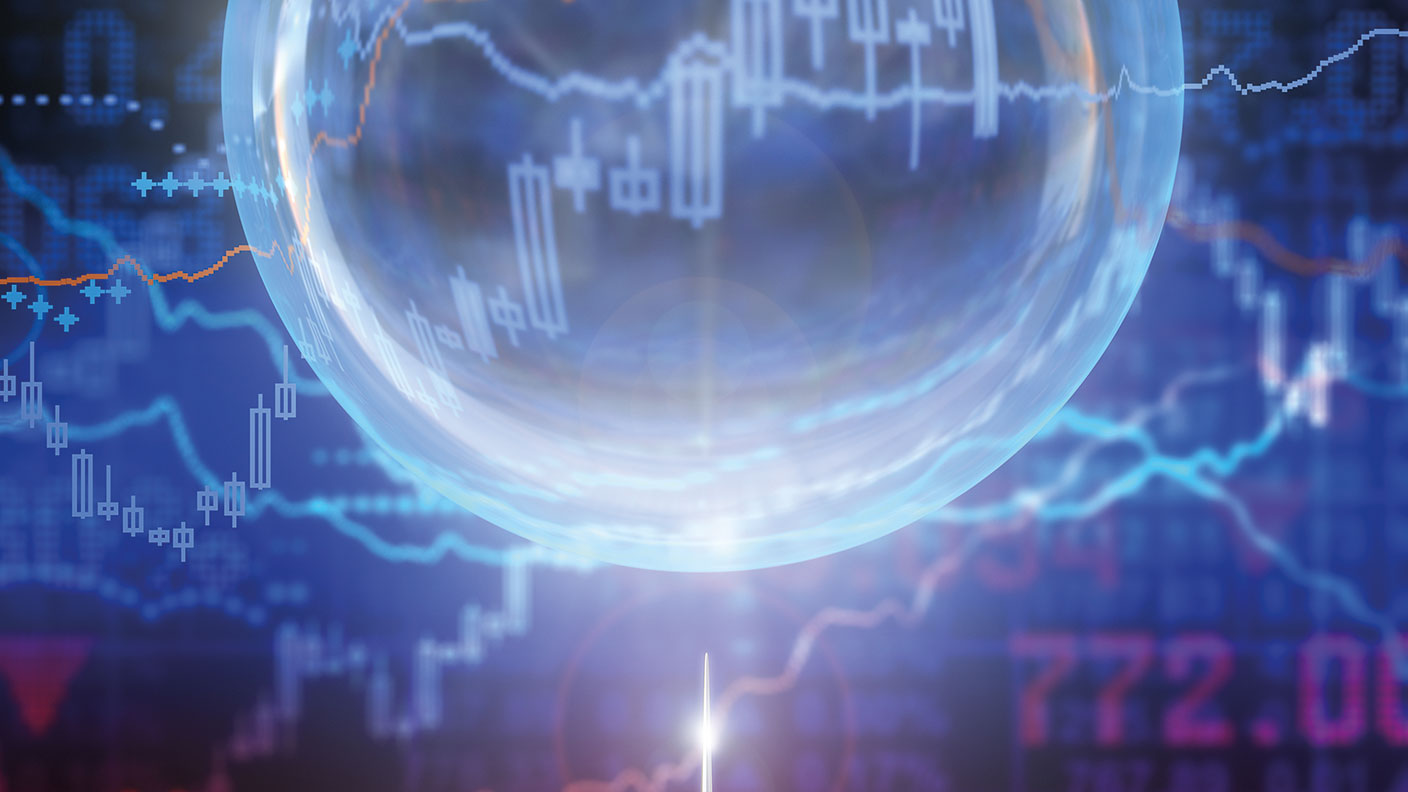US stocks are obviously in a bubble. But is it a rational bubble?
Everyone wants to know if the US stockmarket is in a bubble. But that is the wrong question, says Merryn Somerset Webb. Of course it’s a bubble. The real question is: is it a rational one?


Is the US stockmarket a bubble? That’s the question everyone wants answered right now. It is the wrong question. Of course it’s a bubble. Choose any valuation metric you like in the US and it will tell you so. Yardeni Research puts the ratio of S&P 500 total market capitalisation to S&P 500 forward sales (an adapted version of the “Warren Buffett indicator”) at a record 2.54 times at the end of December, versus 1.88 at the beginning of 2000. A bubble. A full 53% of S&P stocks had forward price/earnings ratios of over 20 times in the first week of January – it was a little higher in June last year, but that aside is the highest since the series began in 2006. Bubble.
The percentage of stocks in the US trading above the 200-day moving average is at a ten-year high. Within almost all sectors, more than 90% of stocks are trading above their 200-day moving averages (notable exceptions, says Variant Perception, include biotech, junior gold miners, utilities and energy). Bubble. All technical indicators show what Variant describes as “extreme overbought market conditions” and 89% of respondents to a Goldman Sachs survey said they expect stocks to rise this year. Bubble.
But on top of all this number stuff, we are also getting a fabulous crop of delicious new market mania stories. There is a SPAC planning to launch with the ticker LMAO (if you don’t use social media, ask your kids). There is the poor man who technically owns $250m worth of bitcoin (worth $20,000-ish when he got them in 2011) but has only two password attempts left to get access to the hard drive they are on (see this week's magazine for more on bitcoin and listen to this week’s podcast for the full story). And of course there is the brilliantly extraordinary Elon Musk, a man who has accumulated wealth faster than anyone else ever in the history of the world. Bubble? Oh yes.
MoneyWeek
Subscribe to MoneyWeek today and get your first six magazine issues absolutely FREE

Sign up to Money Morning
Don't miss the latest investment and personal finances news, market analysis, plus money-saving tips with our free twice-daily newsletter
Don't miss the latest investment and personal finances news, market analysis, plus money-saving tips with our free twice-daily newsletter
The more interesting question then is not: “Is this a bubble?” but: “Is it a rational bubble?” (If there is such a thing.) You can make a pretty good argument for the latter. It’s hard to see where else other than equities (and gold...) money goes when bond yields are still near record lows and global money creation keeps taking out record highs. In 2008, the UK put in place economic stimulus to the tune of 1.5% of GDP to ease us through the financial crisis. This time it’s 26%, according to Minerva Research. The numbers for the US are 4.9% and 18%. M2 (one measure of the supply of money) in the US is up 26% year on year. None of us have ever seen numbers like this before.
You can also argue that while the economy doesn’t look tip top right now, there is fabulous momentum behind recovery: earnings should explode next year, albeit from a very low base. So what do you do? Take a little money out of the most overvalued parts of the market? Sure. Note that some US tech stocks (to say nothing of bitcoin) are topping out and see this week's magazine for our worries about super-expensive Indian stocks. Shift your portfolio towards the bits of the market that are not overvalued – energy, smaller companies, financial and healthcare? Definitely. The US market might be experiencing a perfectly rational bubble – but that doesn’t make complacency safe.
Get the latest financial news, insights and expert analysis from our award-winning MoneyWeek team, to help you understand what really matters when it comes to your finances.
Merryn Somerset Webb started her career in Tokyo at public broadcaster NHK before becoming a Japanese equity broker at what was then Warburgs. She went on to work at SBC and UBS without moving from her desk in Kamiyacho (it was the age of mergers).
After five years in Japan she returned to work in the UK at Paribas. This soon became BNP Paribas. Again, no desk move was required. On leaving the City, Merryn helped The Week magazine with its City pages before becoming the launch editor of MoneyWeek in 2000 and taking on columns first in the Sunday Times and then in 2009 in the Financial Times
Twenty years on, MoneyWeek is the best-selling financial magazine in the UK. Merryn was its Editor in Chief until 2022. She is now a senior columnist at Bloomberg and host of the Merryn Talks Money podcast - but still writes for Moneyweek monthly.
Merryn is also is a non executive director of two investment trusts – BlackRock Throgmorton, and the Murray Income Investment Trust.
-
 Why Trustpilot is a stock to watch for e-commerce exposure
Why Trustpilot is a stock to watch for e-commerce exposureTrustpilot has built a defensible position in one of the most critical areas of the internet: the infrastructure of trust, says Jamie Ward
-
 Tetragon Financial: An investment trust with stellar returns
Tetragon Financial: An investment trust with stellar returnsTetragon Financial has performed very well, but it won't appeal to most investors – there are clear reasons for the huge discount, says Rupert Hargreaves
-
 Why Trustpilot is a stock to watch for exposure to the e-commerce market
Why Trustpilot is a stock to watch for exposure to the e-commerce marketTrustpilot has built a defensible position in one of the most critical areas of the internet: the infrastructure of trust, says Jamie Ward
-
 Tetragon Financial: An exotic investment trust producing stellar returns
Tetragon Financial: An exotic investment trust producing stellar returnsTetragon Financial has performed very well, but it won't appeal to most investors – there are clear reasons for the huge discount, says Rupert Hargreaves
-
 How to capitalise on the pessimism around Britain's stock market
How to capitalise on the pessimism around Britain's stock marketOpinion There was little in the Budget to prop up Britain's stock market, but opportunities are hiding in plain sight. Investors should take advantage while they can
-
 London claims victory in the Brexit wars
London claims victory in the Brexit warsOpinion JPMorgan Chase's decision to build a new headquarters in London is a huge vote of confidence and a sign that the City will remain Europe's key financial hub
-
 The consequences of the Autumn Budget – and what it means for the UK economy
The consequences of the Autumn Budget – and what it means for the UK economyOpinion A directionless and floundering government has ducked the hard choices at the Autumn Budget, says Simon Wilson
-
 Reinventing the high street – how to invest in the retailers driving the change
Reinventing the high street – how to invest in the retailers driving the changeThe high street brands that can make shopping and leisure an enjoyable experience will thrive, says Maryam Cockar
-
 8 of the best houses for sale with electric vehicle charging
8 of the best houses for sale with electric vehicle chargingThe best houses for sale with electric vehicle charging – from a converted World War II control tower in Scotland, to a Victorian country house in Cumbria
-
 Big Short investor Michael Burry closes hedge fund Scion Capital
Big Short investor Michael Burry closes hedge fund Scion CapitalProfile Michael Burry rightly bet against the US mortgage market before the 2008 crisis. Now he is worried about the AI boom
